Reptile & Amphibian
News Blog
Keep up with news and features of interest to the reptile and amphibian community on the kingsnake.com blog. We cover breaking stories from the mainstream and scientific media, user-submitted photos and videos, and feature articles and photos by Jeff Barringer, Richard Bartlett, and other herpetologists and herpetoculturists.
Tuesday, October 21 2025

In 1995 I, along with some other reptile enthusiasts (Joe Forks,Gerry Salmon, Troy Hibbitts, and others) created a web page for gray-banded kingsnake hobbyists called The Alterna Page. By 1997 one thing led to another and it had morphed into what today is kingsnake.com.
That marks 30 years building and maintaining web communities for reptile hobbyists around the world. That is almost half my life. But all good things eventually must come to an end and after discussing it with our sponsors and staff I have concluded it is time for me to retire to pursue other things in my life, and for kingsnake.com to retire as well.
I want to thank kingsnake.com's primary sponsors, LLLReptile.com and RodentPro.com, along with the staff, Cindy Steinle, Melody Golubski, Mark Kennedy, Gerry Freymann, Dick Bartlett, and Ted Hatfield who volunteered his time looking after our servers. Special thanks go to Christie Keith. It is because of their dedication that kingsnake.com has lasted so long. As well there are literally thousands of other advertisers and community members that made kingsnake.com the place to be for herpetologists and herpetoculturists during its great years, from 1999-2016, when some would say the reptile culture was at it's peak. I met many of these thousands of people at countless reptile expos and consider many of them my friends.
Along the way kingsnake.com pioneered many new things for the reptile community and industry, such as topic/species based message boards (forums), live chat symposiums, reptile blogs, podcasts, and video interviews. Many of the fights in the forums were epic.
Most remembered will be kingsnake.com's classifieds, for many years the Internets most popular reptile and amphibian sales tool. It helped turn a random group of like minded hobbyists into a real industry. At it's peak there were over 2200 active classified accounts.
Officially kingsnake.com will close down on October 31,2025. If you have your pictures on the site, or forum posts or other content that you want to save, please do so now, they will not be available on our systems after October 31. If you have a paid classified or other advertising account your account services will still be functional until October 31, or when your contract runs out if sooner.
If you would like to continue to post classified ads until the close date of October 31,2025 please feel free to register for a free classified account and post away. We will be disconnecting our advertising purchase system this week.
Though we are closing we are not filing bankruptcy. We go out clean, all our debts settled and all our bills paid. And if someone is interested in continuing kingsnake.com's legacy I will entertain offers until October 31
This has been a very hard decision, but it is the right one, and it is the right time. I will miss being an integral part of the reptile hobby and culture.
- Jeff Barringer
Tuesday, February 20 2024

Gallery photo by Doug Beckwith
A Colorado man illegally keeping 2 Gila Monsters as pets was killed after being bitten by one of them last week. The 12 inch Gila, a juvenile, was confiscated by Colorado Parks and Wildlife and will be transported this week to a lab in Greeley at the University of Northern Colorado, known for researching reptile venoms for use in pharmaceuticals.
Gila Monsters, Heloderma suspectum, are the only venomous lizard in the United States and bites from them are quite rare, deaths even moreso, the last recorded death being in 1930. While it is illegal to collect wild Gila Monsters everywhere in their natural range in the United States, Gilas are relatively uncommon in the pet industry, but captive bred specimens are available to those that can obtain the proper licenses and paperwork.
Gila Monsters venom and their unique blood chemistry, have long been subjects of research by the pharmaceutical industry, and research has led to the Semaglutide diabetes drugs Ozempic, Rybelsus, and others.
Read more at:
Gila Death News Article Link
Sunday, December 3 2023

Not really, but this sketch, from the quiz show Question Quest on this weekends Saturday Night Live, is pretty much on point when it comes to the responsibilities that attach when you suddenly acquire a pet that will likely outlive you, your children, and your children's children.
Being a long time owner of a 70lb Sulcatta tortoise this sketch really speaks to me.
Click below to watch the Emma Stone win Speedy on SNL...
Emma Stone meets Speedy the Sulcatta Tortoise
Saturday, November 25 2023
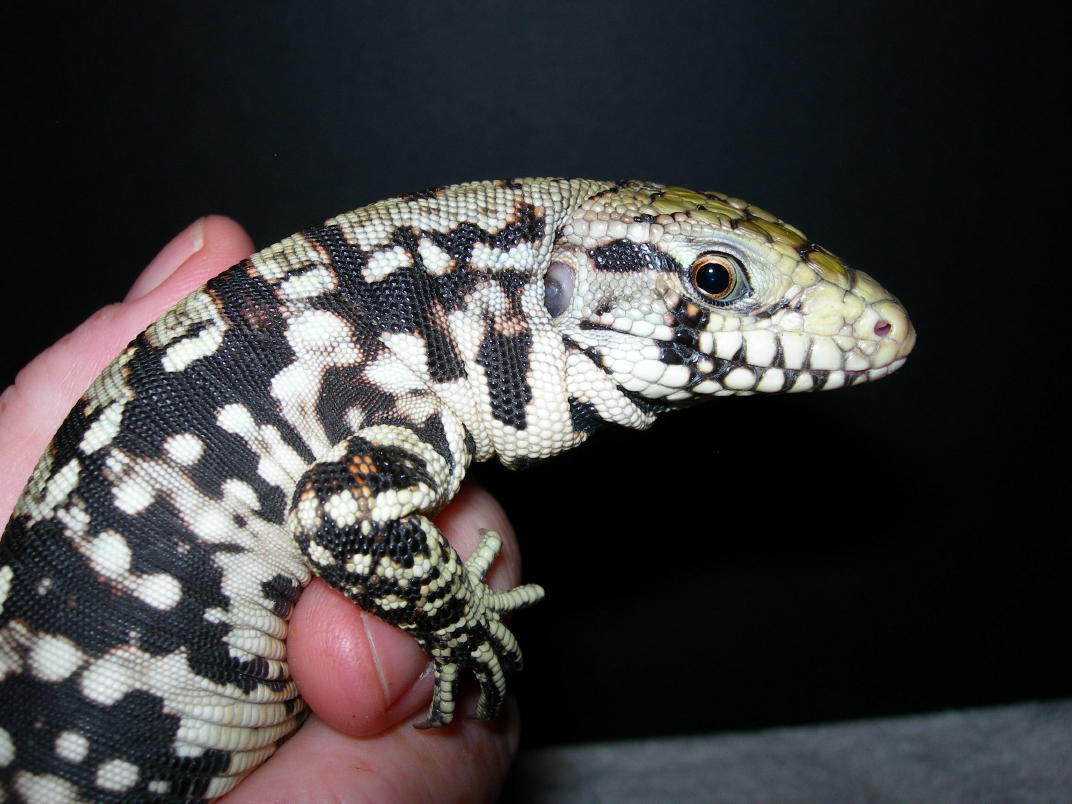
Black & White Tegu photo by user RamblinRose
Herp hobbyists in Georgia are running out of time to register their non-native reptiles with the Georgia Wildlife Resources Commission. The Georgia Department of Natural Resources board voted in 2022 that Burmese pythons can't be bred in the state.
The DNR says the rules are set in place so invasive species don't get released in Georgia. They can survive in the wild and impact the state's native wildlife. Also included in the new law are some tegus, monitor lizards, and turtles.
By Dec. 4, the following reptiles and amphibians must be registered by their owners:
- Nile monitors
- African helmeted turtles
- Chinese softshell turtles
- Argentine black and white tegus
- Indian rock and Burmese pythons
For more information see
Georgia Wildlife Resources Commission - Rules Pertaining to Wild Animals
Saturday, June 25 2022
After many years with our current server farm, they are closing and we will be moving our servers to a new provider this weekend. This will result in about a half a day to a full day of time being offline. We are working closely with our server providers to make this as smooth of a transition as possible.
Thank you for being a loyal kingsnake.com member!
Wednesday, April 20 2022

Gallery Photo by user liamsherps
According to Stew Peters film ‘Watch the Water’ he makes the outrageous claim COVID-19 is snake venom.
"COVID-19 is a synthetic version of “snake venom” that evil forces are spreading through remdesivir, the COVID-19 vaccines and drinking water to “make you a hybrid of Satan.”
Seriously people. I don't even know where to begin with this but I will try.
COVID-19 is a VIRUS, specifically one of the family of Coronaviruses. It attacks the respiratory system and is spread by person to person contact.
Snake venom is a TOXIN. It is a toxin that contains different levels of hemotoxins, which destroy tissue and cells, and neurotoxins which attack the nervous system. They can only be transmitted through direct contact with tissues, usually via snakebite.
Toxins and viruses operate completely differently in the human body, both can make you ill, or even kill you,
but neither will make you a "hybrid of Satan". Whatever that is.
Read more here. https://www.politifact.com/factchecks/2022/apr/19/watch-water/stew-peters-film-watch-water-ridiculously-claims-c/
I can't believe I even have to address this.
Friday, March 25 2022
Tuesday, March 15 2022

kingsnake.com has been hosting reptile businesses from around the world for over 25 years and for a number of years Bion Terrarium Center has been one of those businesses. Located in Kyiv Ukraine Bion has been the source for many unique specimens found in breeding facilities and zoos around the world, as well as supplying reptile keepers in Ukraine with feeders and supplies. With the Russian invasion of the Ukraine the company and it's employees are in dire need of support from the reptile community. If you are looking for someplace in the Ukraine to support with your donations we recommend that you reach out to Bion and offer them what assistance you can. Below is a message from Dmitri Tkachev, owner of the Bion Terrarium Center.
Dear Colleagues, Friends and Partners of BION all over the world,
As a result of unprecedented invasion of Ukraine from Russian Federation, BION’s activities have been paralyzed for an indefinite period of time and we lost all sources of subsistence.
BION Terrarium Center possesses a unique collection of animals (consisting of 2000 heads of breeding stock only), a number of successful long-term and promising breeding programs for many rare species, as well as a team of 30 employees; many of them have been working for more than 15 years. We would be grateful for any support you can provide!
Pls share this info as much as possible!
Please transfer your donations to:
BENEFICIARY: LEOGOL ANIMAL BROKERS
BENEFICIARY’s ADDRESS: 315 N 64th St Seattle, WA 98103, USA
Bank: KeyBank (branch #0164)
Bank address: 353 NE Northgate Way
Seattle, WA 98125
Account #: 471641010460
ABA: 125000574
SWIFT: KEYBUS33
or Pay Pal
leogolbrokers@gmail.com
with a note: Support to BION Terrarium Center due to extreme situation in Ukraine.
Dmitri Tkachev,
On behalf of BION team
P.S. LEOGOL ANIMAL BROKERS, 315 N 64th St Seattle, WA 98103, USA is our reliable partner since 1995!
Monday, March 14 2022
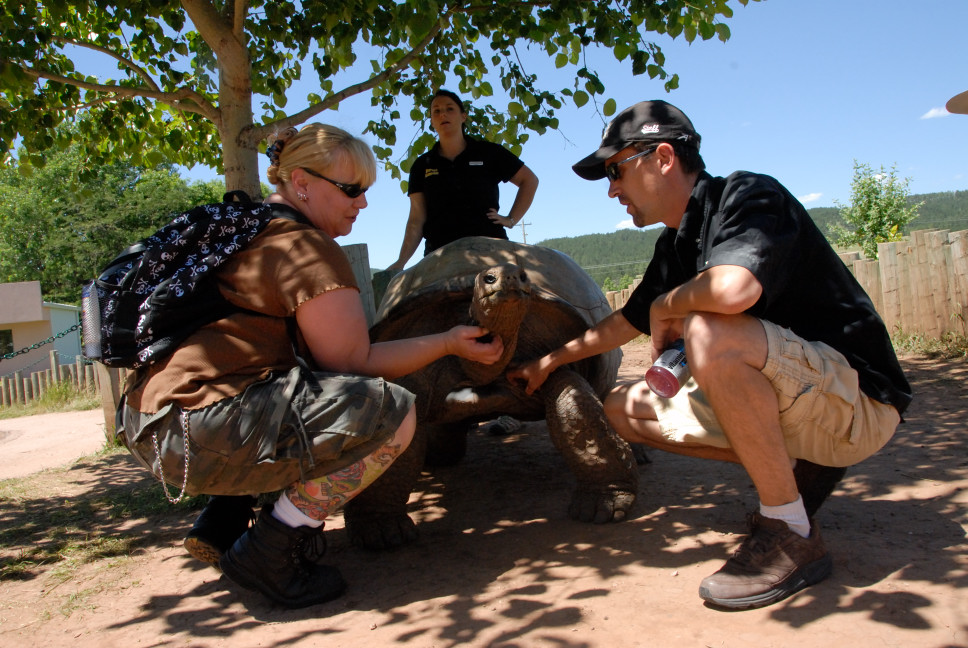
kingsnake.com's Cindy Steinle gets up close and personal with a tortoise at Rapid City's Reptile Gardens
Reptile Gardens in Rapid City is celebrating 85 years of introducing the South Dakotans to reptile species from around the world. Founded by Earl Brockelsby in 1937 it continues to be run by family members, including his nephew, Joe Maierhauser.
Located south of Rapid City, South Dakota, on the road to Mount Rushmore National Memorial. the zoo attracts over a million visitors from around the world every year
The park is open the first Saturday in March through November 30 each year. Reptile Gardens was cited in the 2014 Guinness Book of World Records for being the world's largest reptile zoo.
Read the full article here https://www.keloland.com/news/eye-on-keloland/85-years-at-reptile-gardens/ or visit the Reptile Gardens web site at https://www.reptilegardens.com/
Monday, June 7 2021

Two thieves in a Chevrolet Pickup Truck attempted to steal
this adult Galapagos tortoise from Gerry Fife's breeding facility in Arizona
At 2:30a.m this morning two thieves attempted to steal an adult Galapagos Tortoise from the tortoise breeding facility in Arizona run by long time tortoise breeder Jerry Fife. The breeder sized female tortoise, a critically endangered species, was severely injured in the process and the decision was made to humanely euthanize her. A reward is now being offered to bring the two thieves to justice and video of the attempt is available on Jerry's facebook page. It is hoped that between the herp community and the law enforcement community the miscreants can be identified and arrested. This is a devastating loss for Jerry who is one of the few successful private breeders of the species in the United States. Captive Galapagos tortoises, natives of the Galapagos Islands, can live up to 177 years in captivity and are the largest species of tortoise in existence. Some may weigh over 900lbs.
This is just one of a number of recent reptile thefts in the United States from outdoor captive reptile breeding facilities, causing many of those facilities to tighten their security.
Continue reading "Theives try to steal adult Galapagos Tortoise, maim it instead."
Monday, February 22 2021
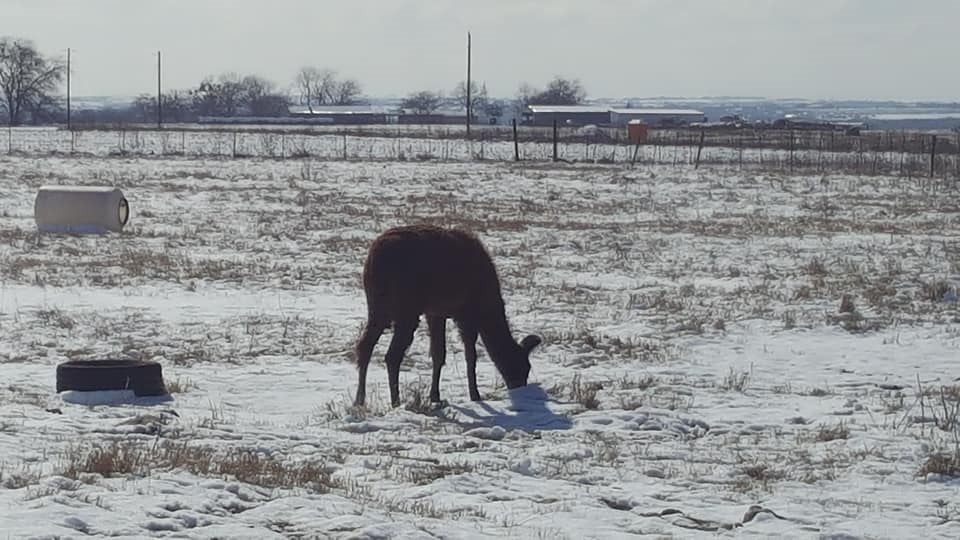
For the first time since launching in February of 1997 kingsnake.com's servers were knocked offline several times for long periods during last weeks polar vortex. The servers, located in Austin Texas, were victims of state mandated rolling blackouts that impacted many areas of Texas. Though the servers were backed up by a large uninterruptible power supply and a commercial generator system, those systems themselves eventually ran out of power. Additionally upstream internet switches also failed due to power issues thus causing a double-whammy, so when power was restored the servers were still unreachable. Those systems have all been restored for several days now and operations are mostly back to normal. Kingsnake.com will be totaling up the downtime and offering our advertisers credit to their accounts once we have determined the extent the outage. We apologize for not being able to provide you the level of service that you have come to expect for the last 24 years, but the situation was beyond our control.
That being said over the last 2 months kingsnake.com has been upgrading to a new set of Dell PowerEdge servers that are bigger, faster, and more capable than our old fleet of PowerEdge servers. For the first time our servers will be "viitualized", utilizing the multiple cores that the more current generation of Intel processors offers. This has required us to upgrade the core software that runs our servers several generations at once, causing a few bugs here and there that need to be squashed. We have gotten most of them but every once in a while a new one unexpectedly crops up. If you hit one of those bugs please let us know by using our contact form.
This weekend we will be upgrading our classified ad server and you can expect brief periods of down time on Sunday, as well as a few bugs going forward. Next weekend we will be upgrading the main site including the blog, events system, business directories as well as other features. We have already upgraded the servers for the forums, forum archives, photo gallery, and banner ad system. We hope to have all our server upgrades completed by March 15.
Monday, April 20 2020

It should be no surprise to the reptile and amphibian community that we would be impacted by the COVID-19 virus shutdowns. We will do our best to keep the herp community informed, here, on this post with the latest meeting and event cancellations. Most of these event cancellations have been mandated by state or local agencies and the event promoters had no say in the cancellations. In all cases it is best to check with the event promoter to check the status of individual events as some may not be listed here. If you are event or meeting promoter that needs to list a cancellation or postponement please send us an email at jeffb@kingsnake.com
List updated 04/20/20
- All Maryland Reptile Show - Havre De Grace, MD - 03/14/20
- North American Reptile Breeders Conference - Tinley Park, Il. - 03/14/20-03/15/20
- Repticon Birmingham, Irondale, AL., - 03/21/20-03/22/20
- ReptiDay Port Charlotte, Port Charlotte, FL., - 03/21/20
- Richmond Reptile Expo - Richmond, Va - 03/21/20
- Reptiles At The York Expo Center, York, PA 03/28/20
- East Coast Rept9le Super Expo - Oaks, PA - 03/28/20
- Repticon Charleston, Mt. Pleasant, SC,- 03/28/20-03/29/20
- Repticon Denver, Aurora, CO,- 03/28/20-03/29/20
- Repticon New Port Richey, Port Richey, FL, - 03/28/20-03/29/20
- Long Island Reptile Expo - Brentwood, NY - 03/29/20
- All Maryland Reptile Show, Havre de Grace, Md. 04/04/20
- Repticon Atlanta, Lawrenceville, GA, - 04/04/20-04/05/20
- ReptiDay Cocoa Beach, Cocoa Beach, FL, - 04/04/20
- ReptiDay Port Charlotte,Port Charlotte, FL, - 04/05/20
- New England Reptile Expo, Manchester, NH, - 04/05/20
- ReptiDay Columbus, Columbus, GA, - 04/11/20
- Northern Virginia Reptile Expo, Manassas, VA, - 04/11/20
- ReptiDay Tallahassee, Tallahassee, FL - 04/11/20
- Repticon Montgomery, Montgomery, AL - 04/18/20-04/26/20
- New York Metro Reptile Expo, White Plains, NY - 04/19/20
- Repticon Tulsa, Kellyville, OK - 04/18/20-04/26/20
- Repticon Chattanooga, East Ridge, TN - 04/25/20-04/26/20
- Repticon Hickory, Hickory, NC - 04/25/20-04/26/20
- All Maryland Reptile Show - Havre De Grace, MD - 05/02/20
- Reptiles At The York Expo Center, York, PA 05/16/20
- Reptiles At The York Expo Center, York, PA 06/27/20
- New York Metro Reptile Expo, White Plains, NY - 07/12/20
Thursday, October 31 2019

kingsnake.com gallery photo
Police say a woman has been found dead with an 8-foot-long python wrapped around her neck at a snake-laden home 20 miles northwest of Lafayette. Details are sketchy at the moment and police have yet to point the blame at the Reticulated Python in question. The woman’s cause of death remains under investigation, with an autopsy scheduled Friday. About 140 snakes were found in the home, the woman owned about 20 of them and had visited the home about twice a week.
The reticulated python ( Malayopython reticulatus) is native to South and Southeast Asia, including India, Burma, Vietnam, Thailand, Malaya, Indonesia, and the Philippines. The worlds longest constricting snake, some specimens are known to exceed 20 ft. in length. An ambush hunter, it waits until prey wanders within strike range before seizing it in its coils and killing by constriction. Its natural diet includes mammals and occasionally birds. Small specimens eat mainly rodents such as rats, whereas larger individuals switch to larger prey including deer and pigs weighing more than 130 lb.
A popular species among reptile hobbyists Reticulated Pythons are common in captivity and have been bred in many different color varieties.
Human fatalities attributed to large constrictors are exceedingly rare but do happen. kingsnake.com wants to emphasize that people working with large or venomous species should always work with a partner to avoid mishaps and injury. No matter how well you think you know an animal it only takes one mistake to have disastrous and sometimes fatal consequences.
For more information on this story please check out https://fox8.com/2019/10/31/indiana-woman-found-dead-with-8-foot-python-around-her-neck/.
Thursday, August 15 2019
 It is with much sadness that kingsnake.com has learned of the passing of reptile industry pioneer Don Hamper.
I first heard Don Hamper's name mentioned by John Hollister in the late 80s while taking a roadside break while hunting for reptiles out near Langtry Texas. It was all "Hamper had those" or "Hamper bred those" or "Hamper can get those". In the days before the internet word passed from herper to herper about other reptile people across the country(and around the world). Don Hamper's name was prominent among them and it seemed that in some way all herp roads led to Don Hamper. I finally actually met Don Hamper at an International Herp Symposium in the early 90s, where most of the reptile illuminati would gather to listen to lectures and compare keeping and breeding notes. By then Don was famous for hosting one of the few regular reptile expos, the All Ohio Reptile Show, as well as for his pioneering work captive breeding many of the species commonly found in the trade today, and through his work introduced literally thousands of midwesterners to the reptile hobby. Don's pioneering work both in reptile breeding and reptile expos dramatically helped expand the hobby into a true industry and his impact can still be seen in the many reptile breeders that sprouted up in America's heartland in the 90s and early 2000s, many of which are still active to this day.
I would run into Don many times over the next 3 decades at symposiums and expos across the country and each time he greeted me like we were long lost brothers. kingsnake.com ended up hosting his web site for many years as well as helping him spread the word about his expos.
I will miss Don and his everpresent smile and kind word. He was a true gentleman and will be missed greatly by all that knew him. Kigsnake.com's prayers go out to the Hamper family and we ask that you keep them in your thoughts.
- Jeff Barringer
Saturday, April 1 2017
 In what may be the most sweeping attempt yet to curb the growing spread of the invasive Burmese Python, President Donald Trump signed an executive order today authorizing the National Park Service to begin construction of a massive snake proof wall around Everglades National Park.
Taking to his Twitter Account the President tweeted;
"Have you seen what they did to the 13th tee at Mar-a-Lago? Very bad. This kind of thing has to be stopped. I saw "Anaconda", with Jennifer Lopez. So sad. What's next? These pythons. They're everywhere. "
"We're going to build a snake proof wall around the Everglades. It will be great. It's going to be the greatest snake proof wall anyone's ever seen. All the other countries are going to be so jealous of our snake proof wall. And we're gonna make Burma pay for it. Believe me. It will create so many jobs. It will be great. Really."
President Trump has directed Ryan Zink, Secretary of the Department of the Interior, to immediately begin taking bids on the design and development of a 30 foot tall barrier around the 1.5 million acre park. The Department of the Interior published two requests for proposals late Friday, which included the specifications it expects for a barrier meant to deliver on President Donald Trump's promise to build a "snake proof wall."
The agency provided 11 threshold requirements for the wall, which it says "shall be physically imposing in height." The wall needs to be 30 feet tall — although "heights of at least 18 feet may be acceptable" — and it should prevent tunneling by going at least 6 feet below ground.
The wall, it adds, should be difficult for getting over and offer features that prevent "sophisticated climbing techniques," though it did not define what that means. Prototypes will also need to prove that they aren't susceptible to a "physical breach"
The federal government expects proposals to be delivered by April 29 and will award a contract based on a prototype that contractors would build around the Mar-a-Lago golf course and club house.
Wednesday, November 25 2015

click to see larger image
Fallout from two highly publicized cobra escapes in Florida is leading to changes in Florida venomous snake regulations in 2016.
According to a memo released by the Florida Fish & Wildlife Commission (see above), the state is banning the use of melamine/particle board enclosures due to their tendency to be warped or damaged by moisture. Venomous Permit holders in Florida have until February 28th, 2016 to bring their caging into compliance.
Also, the Florida is moving ahead with the revision of it's venomous regulations, a process begun last year, before the escapes, with a series of public meetings that began in December of 2014. Based on the input from those 8 meetings, FWC staff is reviewing the recommendations and is preparing draft rules and options for stakeholder input.
If you have questions about either memo, please contact the FWC Captive Wildlife Office at 850-488-6253
Thursday, October 29 2015

In the end it was probably the sign.
There is a right way to run a reptile education program, and then there are other ways.
The first thing any reptile educator needs to do is check to make sure they are not violating either state and local laws, unless they want to get a rather unpleasant education of their own.
Erstwhile reptile educator Jeremy Phillips in Louisville, KY learned this lesson the hard way, when on Tuesday, Louisville Metro Animal Services came and took his four venomous snakes away. Animal Services says that while Kentucky law allows those snakes, a Metro Louisville ordinance does not and the local ordinance supersedes the state law. Phillips says someone snaked him out and reported it to authorities, but he now wants a change in the Metro Louisville ordinance. Phillips will face a judge for his arraignment next month and his case is the first of its kind in Louisville.
He had been putting on free snake shows, but recently was asking for five dollars to cover costs of snake food and electricity to keep them warm. No one has paid for the shows. Phillips said he just put up a sign advertising his $5 snake shows, which he thinks may have gotten him in trouble.
Read more and watch the video at WDRB.com
Thursday, October 8 2015
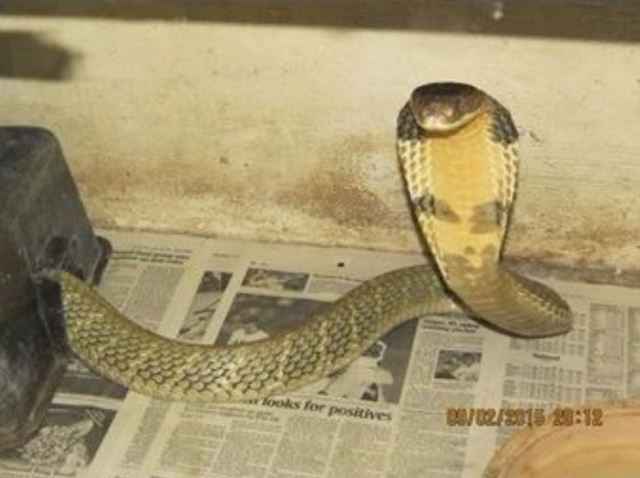
A missing King Cobra that went on walkabout over a month ago has turned up underneath a clothes dryer at a neighbors house a half mile from it's cage. Found Wednesday night Orange County Animal Control officials and the wife of the snake’s owner confirm the snake is the one that escaped 35 days ago and it has been returned to its owners.
“Every time I put something in the dryer this hiss sound happened.” - Cynthia Mullvain
The cobra’s owner, Mike Kennedy, is facing charges for failure to immediately report the escape and has pleaded not guilty.
To read more check out the article at http://wfla.com/2015/10/08/missing-king-cobra-snake-found-in-orange-county-home/

Just days after capturing the once-missing king cobra from a local garage, Florida wildlife officials on Friday confirmed their intent to revoke the owner's license to own the venomous snake in a revocation letter, sent a day before the king cobra was captured. "Allowing you to continue to possess your venomous reptiles after three escapes would send a message that there will be no consequences for serious rule violations,"
The owner of the cobra has held permits to keep various exotic and potentially deadly animals for years, but records show numerous violations for not properly containing the animals including being cited in 2001 after another king cobra escaped from a house in the College Park area of Orlando, and in 2004 when an albino diamondback rattlesnake escaped and ended up in a neighbor's yard.
Read more at the Orlando Sentinel
Monday, October 5 2015

In what is likely to be the first of a number of reptilian additions the Black Pine Snake, Pituophis melanoleucus lodingi, has been added to the USFWS Threatened and Endangered Species List. Found in southwestern Alabama through southeastern Mississippi into eastern Louisiana, Black Pine Snakes are the only melanistic pine snake, ranging in coloration from an overall black and brown banded snake to a nearly jet-black animal. A threatened designation means a species is at risk of becoming endangered within the foreseeable future. The snake’s threatened status allows the USFWS to include exemptions allowing certain management activities to continue to occur with protection from the loss, injury or harassment.
“We crafted the exemptions to provide landowners flexibility to manage for their objectives while still affording conservation benefits to the black pinesnake,” - Cindy Dohner, USFWS Southeast Regional Director.
The Black Pine Snake’s decline is primarily attributed to the loss and degradation of the longleaf pine ecosystem because of habitat fragmentation, fire suppression, conversion of natural pine forests to densely stocked pine plantations, and agricultural and urban development. Other threats to the snake’s survival include road mortality and killing by humans.
The Black Pine Snake was added to the US Fish and Wildlife Services list of candidates for federal protection in 1999, and the Service published a proposed rule to list the black pinesnake as threatened on October 7, 2014. The black pinesnake final listing becomes effective on November 5, 2015 which is 30 days after its publication in the Federal Register on October 6, 2015. The decision is part of the Service’s effort to implement a court-approved settlement under an agreement aimed at significantly reducing it's current litigation-driven workload.
To read the USFWS Press Release click here. Gallery photo by user noMad627
Monday, September 28 2015

The U.S. Fish and Wildlife Service is initiating status reviews for 14 petitions that presented substantial information that the species may warrant listing under the Endangered Species Act . The Service will initiate a review of the status of each of the reptile and amphibian species listed below. To ensure that these reviews are comprehensive, the Service is requesting scientific and commercial data and other information for each species. Based on the status reviews, the Service will address whether the petitioned action is warranted.
To see the listing and the information request, click on a species link below.
The official notice was published in the Federal Register on September 18, 2015, and is available at https://www.federalregister.gov/public-inspection by clicking on the 2015 Notices link under Endangered and Threatened Wildlife and Plants. Information can be submitted on species for which a status review is being initiated, using the specified docket number, beginning upon publication in the Federal Register, for 60 days until November 17, 2015.
kingsnake.com gallery photo by Leo
Monday, August 31 2015

According to scientists at Arizona State University, climate change will be very hard on many species of lizards, driving many species to, or over, the brink of extinction. Biologists led by ASU investigators determined that lizard embryos die when subjected to high temperatures(110 degrees F) even for a few minutes.
“Lizards put all of their eggs in one basket, so a single heat wave can kill an entire group of eggs,” Ofir Levy - lead investigator
Embryonic lizards are immobile in their eggs and cannot seek shade or cool off when their surrounding soil becomes hot. Given the potential impacts of climate change on embryos, many more places in the United States could become uninhabitable for existing lizard populations than previously expected.
To read more check out the article on the ASU News site. Gallery photo by stevereecy
Friday, August 28 2015

The Arizona Game & Fish Department is planning a large adoption event Sept. 5th to help find new homes for about 60 desert tortoises. They've had about 300 tortoises end up at their center over the past year, so many that they don't have names, but rather numbers to keep track of them all. To help make room, Game and Fish started an adoption program for the tortoises.
"We've been having an issue with people breeding in their homes or people need to surrender their tortoise, and they have nowhere to go," Tegan Wolf - Tortoise Adoption Specialist
There is no fee, but there is an application and certain requirements you have to meet, including having an appropriate habitat and burrow. Starting in December it's going to be illegal for captive desert tortoises to be bred in the home. For more info, click here to read the story at KPHO
kingsnake.com gallery photo by TonyC130
Wednesday, August 26 2015

A California man may lose his hand after an attempt to take a 'selfie" with a rattlesnake went wrong. Alex Gomez, 36, spotted the four-foot snake in a field by his family’s ranch. Alex’s nephew, Ronnie, who was with him says the reptile gave plenty of warning.
“It was really thick and had ten rattles on it, it was rattling,” “It was pretty mad.” - Ronnie
After being bitten, Gomez experienced excruciating pain, his hand swelled up and his body started to tingle.
To read more check out the story and video at kcal9
Photo: kcal9
Tuesday, August 25 2015
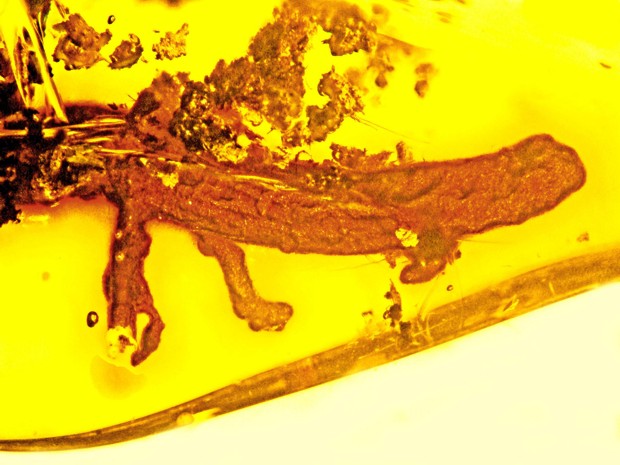
Scientists at Oregon State University are currently studying a baby salamander encased in an amber sample found in an amber mine in the Dominican Republic. There are no salamanders living on islands in the Caribbean today, but the amber-coated amphibian found shows there once were.
"There are very few salamander fossils of any type, and no one has ever found a salamander preserved in amber," - OSU Professor Emeritus George Poinar, Jr.
The sample containing the salamander hatchling measures under an inch in length is an extinct, and the amphibian is a previously undiscovered species, now named Palaeoplethodon hispaniolae, that dates back to between 20 million and 30 million years. For more details check out the paper published online in the journal Palaeodiversity.
Photo: George Poinar, Jr., Oregon State University
Monday, August 24 2015

Old school.
If you knew Tommy Yarborough you're pretty much old school. Tommy was old school. Tommy was a herp legend, who spent over 3 decades traveling from herp spot to herp spot, catching snakes, lizards, turtles and more for his Yarbrough Snake Ranch in Eastaboga Alabama. Back in Alabama he and his wife Mary Ann would put on reptile shows for schools, scouts, church groups and more, entertaining and educating thousands of kids over the years, and starting many a herper down the path.
An early brochure for the Yarbrough Snake Ranch advertises that the "excitement and mysteries of nature are brought to life" — including "cobras (Indian, African and Taiwan), pythons, rattlesnakes, boa constrictors, cottonmouth water moccasins, copperheads, African puff adder, king snakes, rat snakes and tropical snakes."
Today his daughter, Rebecca Yarbrough Tucker, continues Tommy's reptile legacy in Alabama. She has help from her husband, Ken, who helps her care for the more than 300 snakes and other animals at the family’s home in Eastaboga and two volunteers who help with the shows. She donates half of the proceeds of each show to the schools, just as her father did.
The Yarbroughs will be remembered at a special "Reptiles Alive!" show on Saturday August 29 as part of the Anniston Museum of Natural History’s annual Museum Day celebration. Museum admission, programs and activities will be free. To read more, check out the full article at The Anniston Star
Editors note - I met Tommy and Mary Ann several times on the River Road and in Langtry in the late eighties and early nineties. Tommy was a "fast" cruiser and would barrel down the road at 60-70 miles per hour in a big van with ammunition crates roped to the top for the rattlesnakes. Tommy was a character remembered by all that met him.
Wednesday, August 19 2015

Today is Nag Panchami, a traditional day of worship of snakes or serpents observed by Hindus throughout India and also in Nepal. On the Nag Panchami day Nag, cobras, and snakes are worshiped with milk, sweets, flowers, lamps and even sacrifices. Images of Nag deities made of silver, stone, wood, or paintings on the wall are first bathed with water and milk and then worshiped with the reciting of mantras. The piety observed on this day is considered a sure protection against the fear of snake bite. At many places, real snakes are worshipped and fairs held. On this day digging the earth is taboo as it could kill or harm snakes which reside in the earth.
In the past people would gather serpents, and snake charmers would bring their finest snakes to the temples, but changes in India's laws have made snake charming and snake possession illegal, changing the way the event is celebrated for most. Though some still try to celebrate the old ways, authorities keep a watch over events, confiscating and releasing snakes used by the celebrants.
"It's the cobra and rat snakes that are most commonly displayed by snake charmers. We urge people to be alert and capture their pictures and alert the local police station or snake rescue helplines so that they can be nabbed and the snake be freed from torture." Nitin Walmiki - Eco-Echo
To read more about Nag Panchami click here!. kingsnake.com gallery photo by BakerReptiles
Tuesday, August 18 2015

The California Department of Fish and Wildlife (CDFW) is seeking information relevant to a proposal to list the flat-tailed horned lizard as an endangered species. The flat-tailed horned lizard ( Phrynosoma mcallii) inhabits desert habitats in southeastern California, the extreme southwestern portion of Arizona and the adjacent portions of northeastern Baja California Norte and northwestern Sonora, Mexico.
In June 2014, the Center for Biological Diversity (CBD) submitted a petition to the California Fish and Game Commission (Commission) to formally list the flat-tailed horned lizard as endangered under the California Endangered Species Act. As part of the status review process, CDFW is soliciting information from the public regarding the species’ ecology, genetics, life history, distribution, abundance, habitat, the degree and immediacy of threats to reproduction or survival, adequacy of existing management and recommendations for management of the species. Comments, data and other information can be submitted in writing to:
California Department of Fish and Wildlife
Nongame Wildlife Program
Attn: Laura Patterson
1812 9th Street
Sacramento, CA 95811
Comments may also be submitted by email to wildlifemgt@wildlife.ca.gov. If submitting comments by email, please include “flat-tailed horned lizard” in the subject heading.
To read the full press release click here. kingsnake.com gallery photo by Duner.
Monday, August 17 2015
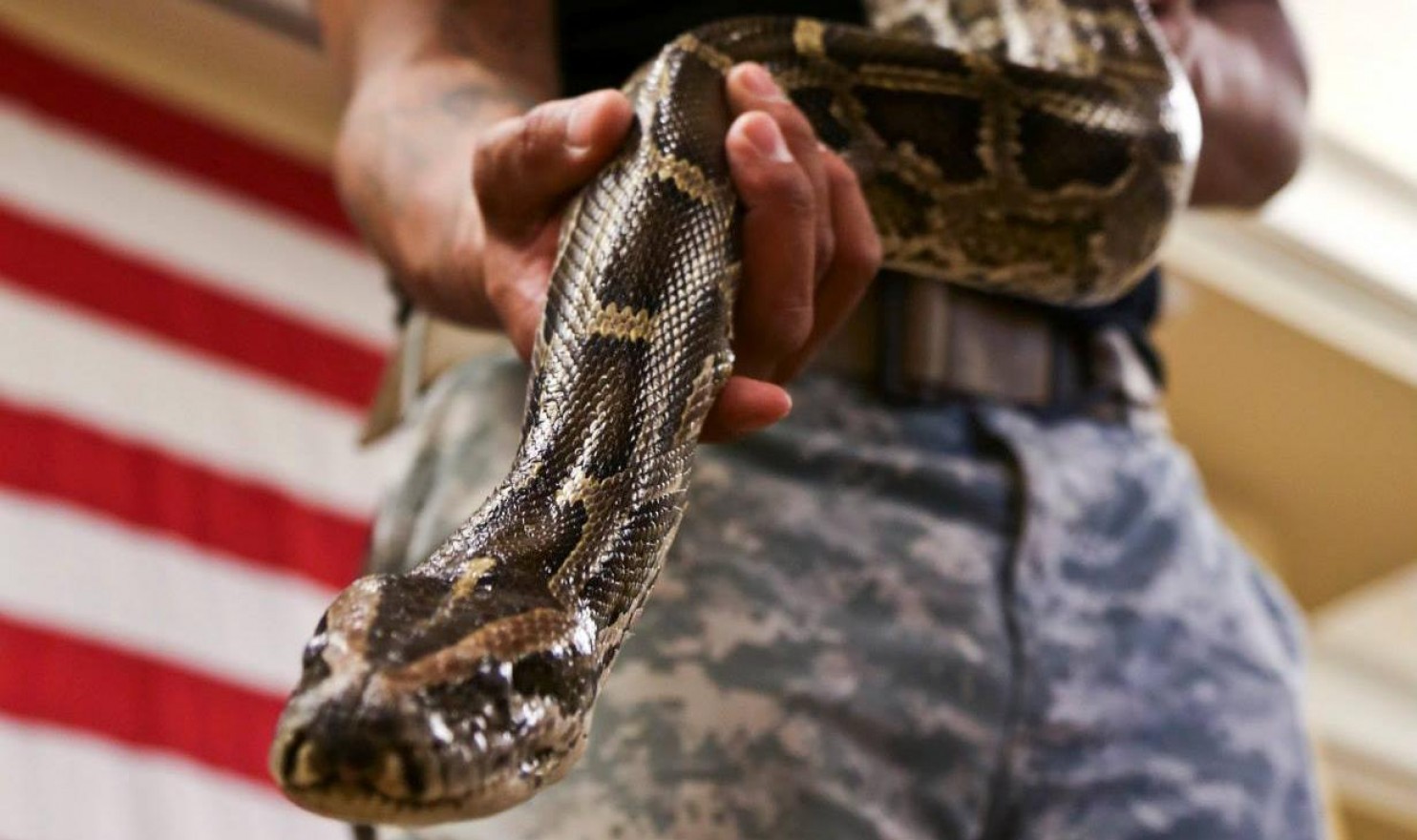 You're low crawling through the underbrush, geared up, M4 rifle in hand, helmet hanging low over your brow, and sweat dripping into your eyes. Then you see it.
Right in your path. A snake.
From the jungles of the Philippines and Vietnam to the deserts of Iraq and Afghanistan, members of the armed forces have long encountered snakes, often at the most inopportune times, and in the most inconvenient places.
“The students, they see them time and time again,” said Staff Sgt. Heath Hensley, a Ranger instructor and member of the reptile team. “You’ll hear them yell out ‘Snake!’ most of the time, and that starts a tactical pause.”
How does the military deal with this problem? Snake school.
Camp Rudder, part of the sprawling Eglin Air Force Base complex, is home to the U.S. Army Rangers reptile house, incorporated into training as students undergo the third and final phase of Ranger School. Its role is to teach students how to overcome their fears of snakes and other reptiles and identify them when they see them. To read more about this fascinating and little known part of military training click here and read the full article at The Washington Post.
(Photo by Staff Sgt. John Bainter/ U.S. Air Force)
Saturday, August 15 2015

Ever thought of starting an alligator farm? In your basement? In Canada?
Rescuers had their hands full in Canada this week when a reptile hobbyist with an affectation for crocodilians decided he could no longer care for his charges properly, and "donated" them to a zoo - all 150 of them. The list includes crocodiles, alligators, and caimans, some as long as 9 feet.
“I think [the owners] just realized that enough is enough, and they need a larger place,” “Kudos to them. A lot of people don’t do the right thing with exotic pets, and they actually did.” - Bry Loyst - Indian River Reptile Zoo
Reptile people are sometimes thought of as "a bit crazy" and stories like this one continue to reinforce that stereotype and leave even experienced reptile hobbyists scratching their heads.
To read more check out the article at the Toronto Star . kingsnake.com gallery photo by user bci32
|



